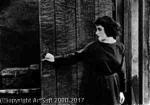Tina Modotti
Tina Modotti
สถานที่: Udine
เกิด: 1896
ความตาย: 1942
ชีวประวัติ:
Tina Modotti 1896 – January 5, 1942) was an Italian photographer, model, actress, and revolutionary political activist for the Comintern. She left Italy in 1913 and moved to the USA, where she worked as a model and subsequently as a photographer. In 1922 she moved to Mexico, where she became an active Communist.
Modotti was born Assunta Adelaide Luigia Modotti Mondini in Udine, Friuli, Italy. Her mother, Assunta, was a seamstress and her father, Giuseppe, was a mason. In 1913, at the age of 16, she immigrated to the United States to join her father in San Francisco, California.
Attracted to the performing arts supported by the Italian émigré community in the San Francisco Bay Area, Modotti experimented with acting. She appeared in several plays, operas, and silent movies in the late 1910s and early 1920s, and also worked as an artist's model.
In 1917, she met Roubaix "Robo" de l'Abrie Richey. Originally a farm boy from Oregon named Ruby Ritchie, the artist and poet assumed the more bohemian name Roubaix. In 1918, Modotti began a romantic relationship with him and moved with him to Los Angeles in order to pursue a career in the motion picture industry. Although the couple cohabitated and lived as a "married couple", they were not married. Often playing the femme fatale, Modotti's movie career culminated in the 1920 film The Tiger's Coat. She had minor parts in two other films.
The couple entered into a bohemian circle of friends. One of these fellow bohemians was Ricardo Gómez Robelo. Another was the photographer, Edward Weston.
It is supposed that Modotti was introduced to photography as a young girl in Italy, where her uncle, Pietro Modotti, maintained a photography studio. Later in the U.S., her father briefly ran a similar studio in San Francisco. While in Los Angeles, she met the photographer Edward Weston and his creative partner Margrethe Mather. It was through her relationship with Edward Weston that Modotti developed as an important fine art photographer and documentarian. By 1921, Modotti was Weston's lover. Ricardo Gómez Robelo became the head of Mexico's Ministry of Education's Fine Arts Department, and persuaded Robo to come to Mexico with a promise of a job and a studio.
Robo left for Mexico in December 1921. Perhaps unaware of his affair with Modotti, Robo took with him prints of Weston, hoping to mount an exhibition of his and Weston's work in Mexico. While she was on her way to be with Robo, Modotti received word of his death from smallpox on February 9, 1922. Devastated, Modotti arrived two days after his death. In March 1922, determined to see Robo's vision realized, she mounted a two-week exhibition of Robo's and Weston's work at the National Academy of Fine Arts in Mexico City. She sustained a second loss with the death of her father which forced her return to San Francisco later in March 1922. In 1923, Modotti set sail for Mexico City with Weston and his son Chandler, leaving behind Weston's wife Flora and their youngest three children. She agreed to run Weston's studio free of charge in return for his mentoring her in photography.
Together they opened a portrait studio in Mexico City. Modotti and Weston quickly gravitated toward the capital's bohemian scene, and used their connections to create an expanding portrait business. Together they found a community of cultural and political "avant-gardists", which included Frida Kahlo, Guadalupe Marín, Diego Rivera, and Jean Charlot. In general, Weston was moved by the landscape and folk art of Mexico to create abstract works, while Modotti was more captivated by the people of Mexico and blended this human interest with a modernist aesthetic. Modotti also became the photographer of choice for the blossoming Mexican mural movement, documenting the works of José Clemente Orozco and Diego Rivera. Between 1924-1928, Modotti took hundreds of photographs of Rivera's murals at the Secretariat of Public Education in Mexico City. Modotti's visual vocabulary matured during this period, such as her formal experiments with architectural interiors, flowers, and urban landscapes, and especially in her many lyrical images of peasants and workers. In 1926 Modotti and Weston were commissioned by Anita Brenner to travel around Mexico and take photographs for what would become her influential book Idols Behind Altars. The relative contributions of Modotti and Weston to the project have been debated. Edward Weston's son, Brett Weston, who accompanied the two on the project, indicated that the photographs were taken by Edward Weston.
In 1925, Modotti also joined International Red Aid, a Communist organization. In November 1926, Weston left Mexico and returned to living in California. It was also during this time that Modotti met several political radicals and Communists, including three Mexican Communist Party leaders who would all eventually become romantically linked with Modotti: Xavier Guerrero, Julio Antonio Mella, and Vittorio Vidali.
More...
Wikipedia link: Click Here



![[Edward Weston] [Edward Weston]](https://img.wikioo.org/ADC/art.nsf/get_small_image_wikioo?Open&ra=D3YL83)








